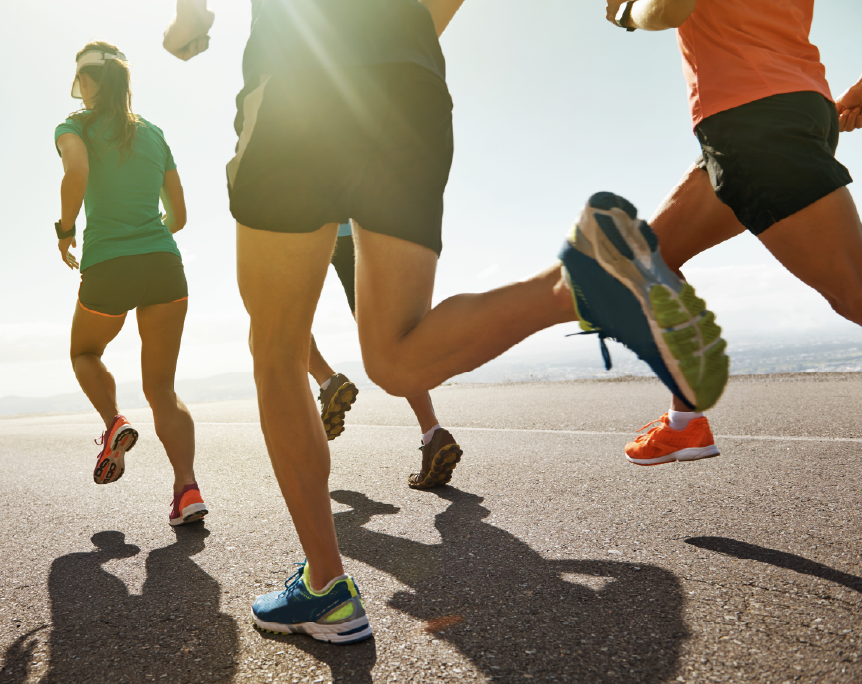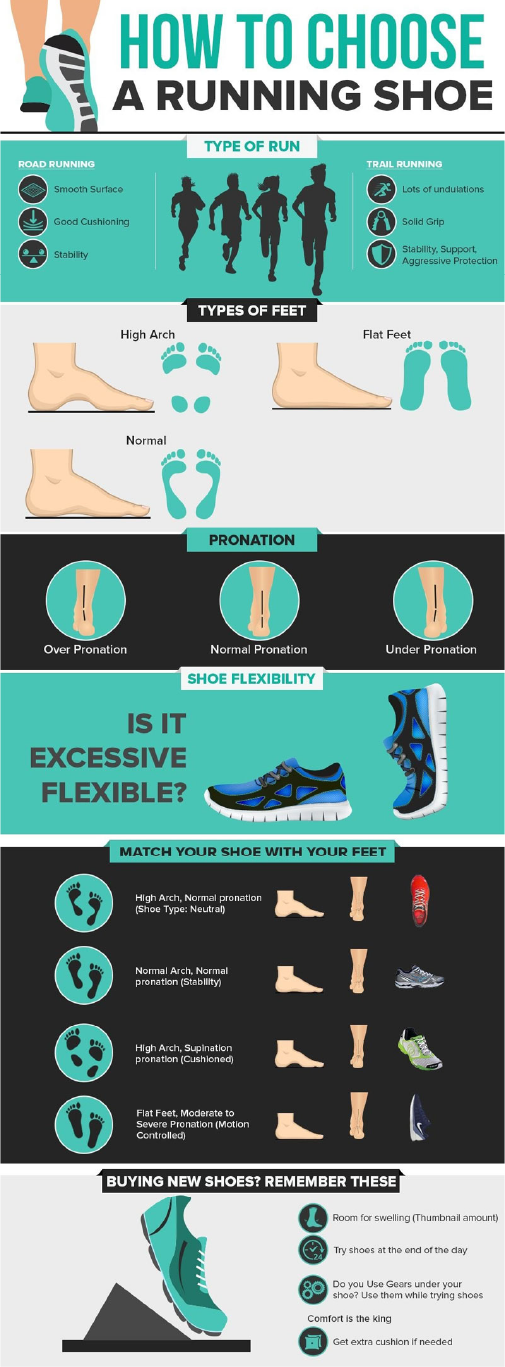
April 11, 2025
Coryell Health’s Ultimate Guide to Choosing the Right Running Shoes
Spring is here, and the weather is perfect for getting out and going on runs before the Texas heat truly kicks in. In a sea of neon colors and notable brand names fighting for your attention on the shelves, how do you know which pair of running shoes is right for you?
April is National Foot Health Awareness Month, and Coryell Health and Dr. Townson understand the importance of wearing the best shoes for foot health. Everyone’s feet are different, and it’s important to tailor your shoes to your feet’s unique needs. We’re here to help you choose the best running shoes for your feet, whether you have flat feet, medium arches or high arches.
Types of Feet
The words “low,” medium” and “high” can be relative. Some people may have an idea of what category their feet fall into, but if you don’t, here is a general guide to identifying different types of feet.
To determine what kind of arches you have, you can conduct an at-home “wet test.” Wet the soles of your feet in the shower and step onto a piece of paper or cardboard. Then, take a look at the imprint your feet made. To see what your results mean and learn more about different arch types, read about the three main categories below.
Flat Feet
- The wet test will show a filled-in or mostly filled-in footprint.
- Having flat feet means having a low or nonexistent arch when standing with weight on both feet.
- When walking or running, your feet tend to naturally roll inward to help distribute impact (this is also called pronation).
Click here to see what to look for in a pair of running shoes for flat feet.
Medium Arches
- The wet test will show that the middle part of your arch is about half-filled with a noticeable curved line along the arch.
- Your arch supports your body weight effectively.
- Your feet naturally roll in, or pronate, under a normal load.
Click here to see what to look for in a pair of running shoes for medium arches.
High Arches
- The wet test will show the ball and heel of your foot with little to no indentation in the middle.
- When walking or running, your feet tend to naturally roll outward to help distribute impact (this is also called supination).
Click here to see what to look for in a pair of running shoes for high arches.

What to Look For in a Running Shoe
According to a 2024 article published in the Journal of the Foot and Ankle, three key characteristics of a running shoe that may improve performance and decrease the risk of injury are shoe drop, cushioning and stiffness.

Shoe Drop
Shoe drop is how much of a heel a shoe has measured in millimeters. It’s the difference in height between the midsole and heel of a shoe. If you’re having trouble visualizing this, think about high heels and how they’re referred to as “3-inch heels” or “5-inch heels.” No agreed-upon “ideal” shoe drop exists, and your comfort is the most important factor when considering different shoe drops.
Lower-drop shoes (0-6 mm) tend to place more strain on the Achilles tendon, calf and ankle, while higher-drop shoes (7 mm or higher) tend to place more strain on the knees and hips. Keep this and your existing conditions in mind when browsing various shoe drops.
Cushioning
Cushioning refers to the padding in the midsole of a shoe to help absorb impact. Depending on your health conditions, more cushioning isn’t always necessarily a good thing.
If you have a limited range of motion in your ankles, knees or hip joints, more cushioning can help you stay balanced and upright. However, more cushioning tends to create a harder heel strike on the ground, so avoid lots of cushioning if you have heel pain.
Stiffness
Stiffness refers to how flexible a shoe’s midsole is. Today, many brands use the terms “stability” and “motion control” to indicate how flexible or stiff a pair of running shoes is.
Stability running shoes are slightly more flexible compared to motion control shoes. They’re designed to support the arch of the foot and the midsole. Motion control shoes aim to limit excessive foot motion and tend to be more stiff compared to stability running shoes.
With your type of arch and these factors in mind, Coryell Health recommends noting the following characteristics when shopping for your next pair of running shoes.

Best Running Shoes for Flat Feet
To help absorb impact, reduce pressure on your feet and counteract pronation, look for running shoes with:
- Extra arch support
- A firm yet cushioned insole
- A thicker sole
Best Running Shoes for Medium Arches
For less restriction, a comfortable fit and support that fits your arch, look for running shoes with:
- Balanced cushioning
- A flexible midsole
- A heel drop that matches your running style
Best Running Shoes for High Arches
To allow your feet to roll slightly inward as you run and prevent discomfort and potential injuries, look for running shoes with:
- Neutral arch support
- Lots of cushioning
- A firm midsole
Coryell Health recommends the following guides to help determine which specific pair of running shoes is right for you:
- The 6 Best Running Shoes of 2025 from Wirecutter
- What Running Shoes Should I Buy? from Runner’s World
When it comes to protecting your feet from discomfort, pain and injuries, choosing the right shoes for every activity is essential. Dr. James Townson Jr. emphasizes that improper footwear can lead to serious foot problems over time.
“Your feet are the foundation of your body. Wearing the wrong shoes, even for a short period, can cause pain and long-term damage. Choosing footwear designed for your specific activity can help prevent injuries and keep you moving comfortably.” – Dr. James Townson Jr.
Choosing the right pair of running shoes for your feet can help improve performance and reduce the risk of injury and long-term foot and ankle issues. As Coryell County’s only board-certified podiatrist for reconstructive rearfoot and ankle surgery, Dr. Townson understands the impact of proper footwear on long-term foot health.
He is currently accepting new patients in Gatesville, Goldthwaite and Temple. Starting in May, he will also have open appointments at Coryell Health Medical Clinic – Waco. If you have or are concerned about developing foot or ankle problems, call (254) 865-2166 to schedule an appointment with Dr. Townson.

Meet the Doctor
Dr. James Townson Jr earned his bachelor’s degree in biomedical science from Texas A&M University and his doctorate in podiatric medicine from Samuel Merritt University. He then completed his foot and ankle reconstructive surgical residency at the Raymond G. Murphy VA Medical Center in Albuquerque, New Mexico. A podiatric surgery specialist with over 10 years of experience in the medical field, Dr. Townson is board certified in reconstructive rearfoot and ankle surgery by the American Board of Foot and Ankle Surgery and is a fellow of the American College of Foot and Ankle Surgery. He’s also a member of the American Podiatric Medical Association and the Texas Podiatric Medical Association.
 Skip to content
Skip to content
